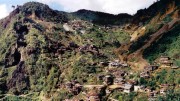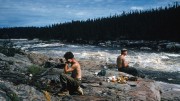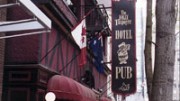The year 1966 was a banner one for exploration, at least for the village of Peachland and the Central Okanagan in B.C.
Noranda’s copper and molybdenum prospect some ten miles west of the village was in high gear and, as was common then, the Howe Street vultures were capitalizing on the Noranda find by staking all the surrounding ground and mining the pocketbooks of the gullible.
My previous experience with moly was limited to one summer at Noranda’s Boss Mountain mine about 60 miles east of 100 Mile House in central B.C.
After thirteen years as a hard-rock underground miner, I had quit that kind of work and had, for the past year and a half, worked as a neophyte superintendent for Mel Abbott and his “Gulf Drilling” company in road-construction blasting.
Mel was an entrepreneur who had grown up in Revelstoke, B.C., where his father was a high-school principal and his mother, a music teacher. His two sisters were not only teachers, but also involved in the arts community. However, Mel’s father had two brothers in Texas who were both businessmen, so Mel came by his talents naturally. He and I shared birthdays but he was three years my junior.
Mel had just spent $50,000 converting his Reichdrill from one using 6.5-inch, tri-cone bits to one using a high-pressure (over 250 psi) down-the-hole hammer drill – the latter being far more economical to operate and maintain.
We were moving that drill up to the Brenda mine property on July 1st, when the truck broke down before quite getting there.
I had been previously informed that there would be rooms for our crew in Noranda’s camp, but I was stopped on the road before reaching the mine by an older gentleman, who inquired, “Where do you think you are going?” I said that was heading for the mine and would be staying in the camp. He responded curtly, “You can’t stay there.” I replied, “It’s OK. Arrangements have been made.” He then repeated, “You can’t stay there. We are closed for the weekend.” I countered, “Who are you?” “My name is Peter Stym and I am the mine manager,” he retorted.
It was not a good way for me to start my relationship with Brenda Mines. We had to find lodging in Peachland for the weekend, and fortunately I seldom had to deal with Mr. Stym directly.
Peachland was small, but it had a hotel with a pub as well as a dance floor with a jukebox. Peter Spackman, the owner, was a genial host and his pub was soon the social centre for the mining crowd. It was busy every night, but Friday and Saturday nights were special, when the place was literally hopping.
I recall one mining engineer at the pub who came close to blows with a fellow from another company whom he accused of short-selling his stock. We found out later that the engineer was the short-seller. His accusations were obviously an attempt to divert suspicion away from himself.
One couple I met was Colin McLoughlin and his wife, Heidi. Colin worked for BrenMac, one of the companies that had staked a large number of claims adjacent to Brenda. Another friend I made (and still have) was Ross Vogan, a young oil field geologist, and his wife Nancy. They shortly moved on to Calgary where Colin went on to work independently and create oil-drilling partnerships on properties he assembled. Yet another was Fred McKenzie, the mine’s office manager, who had just returned from Peru where he had worked at over 12,000 feet above sea-level. He had a Peruvian wife and two young daughters who both competed in javelin at the Olympics a few years later. Fred was an avid golfer with whom I shared a few games at the Kelowna Golf and Country Club.
Mel had negotiated a contract to drill a number of 1,000-feet-deep holes to sample the copper-moly ore. Management wanted to use us as a check against the diamond-drill results, which were suspect. Some of the moly was evidently lost in the diamond-drill water and not always captured due to the faulting in the rock. Our contract price per foot was a little over $7 – the same as that paid to the diamond-drill contractor.
Our drill crew included men with conspicuous names. I had one driller named Green, another named Walker, and a driller’s helper named Ryder. Walker had what I assumed was an English accent, but when I jokingly called him a “Bloody Limey,” he turned pale and I thought he was going to hit me. He controlled himself and replied, “Don’t you ever call me a Limey again.” He was from Australia.
Ron Minshull, my best driller, was a would-be inventor. I had little enthusiasm for the ideas he came up with from time to time as they seemed unlikely to be commercially feasible.
He remained in the drilling industry but maintains a home off the north coast of Vancouver Island in what used to be a Finnish settlement on Sointula Island. Contrary to my expectations, he did eventually patent some accessories that are now popular in the drilling industry.
Mel Abbott was obviously creative, for he had built a unique jeep-mounted sample splitter that captured a mere five percent of the total drill-cuttings. This was important, for the sheer bulk of cuttings from a 15-foot sample in solid granite would have weighed 580 lbs., not including its water content which was sometimes substantial. We used a centrifuge to expel most of the water that accompanied such samples. Our actual samples, being only about 29 lbs., were manageable.
We began our first hole with great expectations which were initially confirmed: the drill cut through that granodiorite rock as though it was cheese, but not for long. The drill stopped abruptly when it encountered a mud seam, of which there were many.
We soon learned that the drill needed solid rock for it to work. No matter what we tried, we could not drill through those mud seams. I don’t recall how long we beat our heads against what at first appeared to be a minor technicality before conceding defeat. We were forced to switch to tri-cone bits with tungsten-carbide inserts. They cost us more than $1,000 each.
Another complication was that we were drilling the holes at a 62° angle instead of vertically. Worst of all, we were soon apprised of another fact about tri-cone bits: the minimum economical diameter for bits of this type was then about 8 inches. The bearings in our bits were too small to handle the required pressure exerted on them and did not last very long.
If memory serves me correctly, the deepest hole we were able to drill was 800 feet, but most of them were less than that. In one hole, the bit lost its cones at 220 feet when its bearings failed and we spent over a day fishing them out.
Those drill bits ate up a significant portion of our contracted price, and since Mel had spent $50,000 converting the drill to high-pressure air, he was soon in financial trouble.
Was there a golden lining in this dark cloud?
Yes, but it was academic. We showed that our methods provided more accurate results, and that there was more moly in the rock than indicated by the diamond-drilling program. This was later verified with bulk samples taken from raises driven up one of our holes and up two diamond drill holes.
After our work at Brenda and with the wolf at the door, Mel grew desperate and tried a number of ways to raise quick cash.
He and I visited a retired prospector in North Vancouver who had a property near the summit of an 8,000-foot-high mountain on the east side of Kootenay Lake. This fellow not only painted a picture of silver-lead-zinc ore assaying forty-five percent lead-zinc, plus several ounces of silver at the portal of a drift that he had driven 50 feet into the mountain, but he told us too that the ore improved with depth.
Mel and I drove to Nelson and, on the way there, we bandied ideas about how to get the ore down to a road, for there were none except for the one beside the river, far below.
Mel chartered a helicopter for the following day, but he came down with nasty flu, so I visited the site alone.
There was indeed some exceptionally rich ore at t
he portal, but only three feet of it at the collar of the adit. The rest of the drift was devoid of any visible mineralization. Whatever ore there might once have been had eroded away eons ago. The prospector had either lied to us, or his memory of the property had changed over time, probably due to wishful thinking – a not-uncommon trait of many prospectors.
Mel lost control of Gulf Drilling and sold it to HB Contracting for pennies on the dollar. We both worked briefly for that company with me taking a twenty percent pay cut.
I left shortly and went to work for Peter Kiewit Sons, a large and successful construction business, where I would spend ten years before becoming an independent consultant.
The Brenda mine went on to become the largest open-pit mine in Canada, with ore production of 35,000 tons per day. It was Canada’s largest copper producer for several years.
Mel became a mining promoter and teamed up with a Vancouver geologist. They acquired a moly property called Payette River Mines near Boise, Idaho, on which I had done the initial chip sampling.
Mel quickly learned how to mine the pockets of investors. I lost a year’s income on the stock and his banker got involved, too. He purchased shares with the bank’s money and went to jail.
Mel was soon a millionaire; but not for long. His mother had two years earlier died from an aneurism while curling at a Revelstoke rink. Now Mel suffered an aneurism as well. He died, not from the aneurism, but from a blood clot that stopped his heart twelve hours after a successful brain
operation.
He had reached the ripe old age of thirty-eight.
– Based in B.C., Larry Jacobsen is author of Jewel of the Kootenays: The Emerald Mine, which is available at Chapters Indigo bookstores at www.chapters.indigo.ca and Gordon Soules Book Publishers in West Vancouver, at www.gordonsoules.com.




Be the first to comment on "Odds ‘n’ sods: Moly Madness: Treasures of the Okanagan Valley"